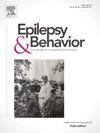Predictive factors and prevalence of acute symptomatic seizures among patients with acute traumatic brain injuries
IF 2.3
3区 医学
Q2 BEHAVIORAL SCIENCES
引用次数: 0
Abstract
Introduction
Traumatic brain injuries (TBI) significantly contribute to hospital admissions in Europe. Acute symptomatic seizures (ASz), occurring within seven days post-TBI, increase morbidity and mortality. This study analyzes the frequency, risk factors, and short-term outcomes of ASz in patients with acute TBI.
Material and methods
This retrospective study included 212 patients with acute TBI admitted to the University Hospital Frankfurt/Germany between 2018 and 2021. Data were collected on demographics, injury characteristics, clinical course, and outcomes. ASz were defined as clinically or electroencephalographically detected seizures within seven days post-TBI. Logistic regression was used to identify predictors of ASz and non-convulsive status epilepticus (NCSE).
Results
ASz occurred in 17.9 % (n = 38) of patients, with a mean latency of 2.4 ± 1.9 days post-TBI. Status epilepticus developed in 47.4 % (n = 18) of these patients, predominantly as NCSE (n = 15). Predictors of ASz included older age (OR = 1.034, p = 0.012), higher Glasgow Coma Scale (GCS) at 24 h (OR = 1.133, p = 0.021), severe TBI (OR = 5.085, p = 0.018), and pneumonia (OR = 5.828, p = 0.007). For NCSE, significant predictors were older age (OR = 1.059, p = 0.021), pneumonia (OR = 6.766, p = 0.012), and urinary tract infection (OR = 7.38, p = 0.012). Patients with ASz had a significantly worse modified Rankin Scale (mRS) score at discharge (OR = 5.01, CI: 1.93–13.0, p < 0.001)).
Conclusion
ASz are a frequent and serious complication of TBI, particularly in severe cases and older patients. Early identification of high-risk patients using predictive factors such as age, GCS, and pneumonia may result in earlier treatment and improved outcomes. The findings highlight the importance of dedicated epilepsy monitoring in acute TBI care.
急性创伤性脑损伤患者急性症状性癫痫发作的预测因素和患病率
在欧洲,创伤性脑损伤(TBI)是导致住院的重要原因。急性症状性发作(ASz),发生在创伤后7天内,增加发病率和死亡率。本研究分析急性脑外伤患者发生ASz的频率、危险因素和短期预后。材料和方法本回顾性研究包括2018年至2021年在德国法兰克福大学医院住院的212例急性TBI患者。收集了人口统计学、损伤特征、临床过程和结果的数据。ASz被定义为tbi后7天内临床或脑电图检测到的癫痫发作。采用Logistic回归确定ASz和非惊厥性癫痫持续状态(NCSE)的预测因子。结果17.9% (n = 38)的患者发生asz,平均潜伏期为2.4±1.9 d。这些患者中有47.4% (n = 18)出现癫痫持续状态,主要是NCSE (n = 15)。ASz的预测因子包括年龄较大(OR = 1.034, p = 0.012)、24 h时格拉斯哥昏迷评分(GCS)较高(OR = 1.133, p = 0.021)、重度脑外伤(OR = 5.085, p = 0.018)和肺炎(OR = 5.828, p = 0.007)。对于NCSE,显著预测因子为年龄较大(OR = 1.059, p = 0.021)、肺炎(OR = 6.766, p = 0.012)和尿路感染(OR = 7.38, p = 0.012)。ASz患者在出院时的改良Rankin量表(mRS)评分明显较差(OR = 5.01, CI: 1.93-13.0, p <;0.001))。结论asz是创伤性脑损伤常见且严重的并发症,以重症和老年患者最为常见。使用年龄、GCS和肺炎等预测因素早期识别高危患者可能导致早期治疗和改善预后。研究结果强调了在急性脑外伤护理中专门监测癫痫的重要性。
本文章由计算机程序翻译,如有差异,请以英文原文为准。
求助全文
约1分钟内获得全文
求助全文
来源期刊

Epilepsy & Behavior
医学-行为科学
CiteScore
5.40
自引率
15.40%
发文量
385
审稿时长
43 days
期刊介绍:
Epilepsy & Behavior is the fastest-growing international journal uniquely devoted to the rapid dissemination of the most current information available on the behavioral aspects of seizures and epilepsy.
Epilepsy & Behavior presents original peer-reviewed articles based on laboratory and clinical research. Topics are drawn from a variety of fields, including clinical neurology, neurosurgery, neuropsychiatry, neuropsychology, neurophysiology, neuropharmacology, and neuroimaging.
From September 2012 Epilepsy & Behavior stopped accepting Case Reports for publication in the journal. From this date authors who submit to Epilepsy & Behavior will be offered a transfer or asked to resubmit their Case Reports to its new sister journal, Epilepsy & Behavior Case Reports.
 求助内容:
求助内容: 应助结果提醒方式:
应助结果提醒方式:


